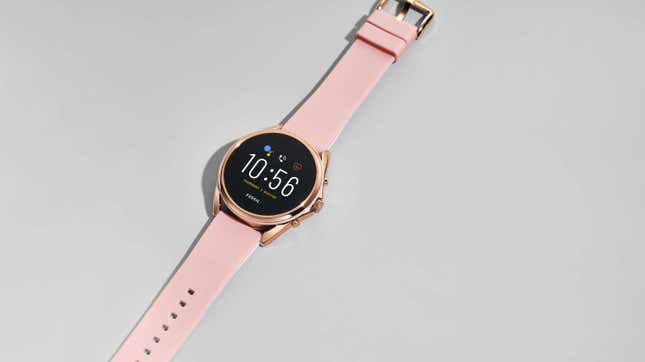
Usually, when people think of wearables, their mind conjures an image of a smartwatch. Fair! But at CES, wearables are a much, much broader category. They include everything from “hearables” and smart rings, to futuristic proof of concept devices that may never actually see the light of day.
While CES 2021 was an all-digital experience, that doesn’t mean we didn’t scour the digital booths for the wearable tech you should definitely know about. On top of smartwatches, this year we saw some cool smart glasses concepts, tons of weird smart masks, and, uh, even a patch meant to be worn in an extremely delicate area. In any case, here are our picks for the wearable tech you should know about from CES 2021.
Fossil Gen 5 LTE

Finally, a cellular Wear OS smartwatch that people might actually use! (RIP LG Watch Sport.) While we’re disappointed that this latest Fossil watch isn’t sporting the new Qualcomm Snapdragon Wear 4100 chip, this is still a big step forward for Fossil and by proxy, Wear OS. True, it’s limited to Android users on Verizon, but if Wear OS is going to make any strides in catching up to Samsung and Apple, cellular capability is a must.
Skagen Jorn

Hybrid smartwatches aren’t new. Hell, hybrid watches from a Fossil brand aren’t even new. That said, the Skagen Jorn is just a gorgeous watch and its e-ink display gives us some nostalgic Pebble vibes. Fossil has also added some new features, including competitions and challenges and a do-not-disturb mode.
Mudra Band
This $180 Apple Watch strap has a unique thing going for it: It lets you control the watch just by making hand gestures. On the inside, there are a series of sensors that can detect electrochemical signals from your brain. Those signals are then run through an algorithm that can detect your individual finger movements. So, for instance, you could pinch your fingers to answer a call from the wrist, or fold your thumb to skip a music track. There are some simple use cases for everyday life, but this tech has plenty of accessibility applications too.
JLab JBuds

We’ve seen open-ear headphones built into eyeglass frames before. (Hello, Bose Frames!) But the cool thing about these JLab JBuds is that they’re not actually built into the frames themselves. They’re $50 clip-ons that let you turn an existing pair of sunglasses (or regular glasses) into a pair of “smart” glasses. We love an affordable, accessible option for some fancy-pants tech!
AirPop Active+ with Halo Sensor

So maybe Razer’s RGB smart mask is flashier, but it’s also a concept device. This thing is an actual product that exists and is pretty smart to boot. The mask itself has a Halo sensor in the mask that then connects over Bluetooth with your phone. The mask can track breathing data, as well as give you real-time insights about air quality and location. It can even tell you what types of air pollutants the mask has blocked via an app. It’ll also remind you when to change your filter, and can be used in an “Active Mode” to track breaths per minute, per pace, etc. while you’re exercising. It uses a coin cell battery, so you don’t actually have to charge it either, and works with iOS and Android. The device comes with four filters and is expected to be available in January for $150.
Vuzix Next Generation Smart Glasses
Vuzix has been in the smart glasses game for a while now. These particular glasses, however, are notable because they don’t look like something that came out of a sci-fi flick—but still contain some neat tech. The glasses incorporate “waveguides with holographic optics,” laser and micro-LED display that can be used indoors and outdoors, open ear audio, and noise-canceling microphones. Vuzix says they’ll be capable of combining “most smartphone and smartwatch capabilities” and expects the glasses to be available later this year.
Lenovo ThinkReality A3

On the complete opposite end of the spectrum, this AR Lenovo headset is leaning in on the whole “glasses of the future” vibe. Are they stylish? Hell no. Are they meant for regular consumers? Absolutely not, this is more for enterprise customers. But it’s impressive that it can handle up to five stereoscopic 1080p displays, sports an eight-megapixel RGB camera, and dual fish-eye cameras for room-scale tracking. It can also plug into your PC or certain Motorola smartphones. These will be available in mid-2021.
Quantum Operation Inc’s Non-invasive Glucose Monitor

This Tokyo-based startup says it’s created the world’s first non-invasive glucose monitor that’s capable of continuous, real-time measurement. The company says it uses “patented spectrum sensing technology” to measure a person’s blood sugar via the wrist. That’s huge for diabetic patients, who traditionally have to prick their skin with needles to get accurate blood sugar readings. It also has major implications for doctors, as it might help them monitor patients remotely—especially if they live in rural areas or aren’t able to travel often. While this isn’t a device that’ll be on the market in the next few weeks or months, it’s cool to see this kind of tech is in the works.
The Taint Bandaid
I have written many words about the taint bandaid, but here I am, writing a few more. It’s technically a wearable patch designed by Morari Medical that’s meant to zap your netherbits with some gentle electroneurostimulation. To help with premature ejaculation. We saw this last year, but back then it was literally a bandaid on a smooth Ken doll mannequin. This year it is real, the design has been updated, Bluetooth has been added, and real people have used it. Morari Medical is aggressively aiming to bring this to market by the end of this year. Count this as one of the more memorable devices to ever come out of CES.
We’re live from our couches covering CES 2021! Click here to read our complete coverage.